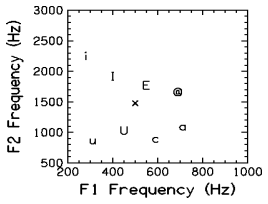Vowel Dynamics

Quite a few studies over the past two decades have shown that American
English vowels are only approximately separable on the basis of static
formant frequency information alone. It appears that the structure of
vowels can only be fully specified when we also describe how formant
frequencies vary from onset to offset of the vowel. The purpose of
this exercise is to explore this important feature of vowel structure
by synthesizing vowels with time-changing formant values and compare
these to static vowels we synthesized in the previous exercise.
Task 1
To do this exercise, we'll need to use the more complicated General Klatt Synthesis interface. Let's start
by getting it to work with an example. The code shown below is a sort
of computer program or script for the speech synthesizer. It instructs the
synthesizer to set various control parameters to specific values at specific
points in time. Lines that begin with an asterisk are
comments. Actual script lines begin with a time value (either absolute like
TIME=000 or relative like TIME+20) which is followed by one or more
other parameter settings (like F1=592 or AV=72). The formant frequency
values in this example are those Hillenbrand et al. (1995)
found for average male /ae/ productions, but the timing values are
fairly arbitrary. So here's the synthesis script:
* Start with formants on slightly high - front /ae/
*
TIME = 000; F1=592; F2=1923; F3=2500; F0=130; AV=30
*
* Ramp AV up over 20 msec to prevent perception of stop
*
TIME + 20; AV=72
*
* Hold formants and amplitude constant for 250 msec.
*
TIME + 250; F1=592; F2=1923; F3=2500; AV=72; F0=120
*
* Over next 200 msec glide into lower - more back /ae/
*
TIME + 200; F1=632; F2=1720; F3=2500; AV=72
*
* Hold constant formants and AV but let F0 drop over 60 msec
*
TIME + 60; F0=90; AV=72
*
* Ramp amplitude back off over final 30 msec
*
TIME + 30; AV=0
END
We're going to make a copy of this script so we can paste it into the
synthesizer interface and generate the speech it describes.
Use your mouse to select the script
by positioning the pointer on the start of the script text, pressing the left
mouse button, and dragging the pointer over the rest of the script. Now
press ALT-C or use the Edit menu to Copy the selected area.
Next, go to the Synthesis
Interface script section, click inside the text entry window and
select Paste from the Edit menu.
Task 2
Jim Hillenbrand was kind enough to supply a listing of the acoustic
measures he and his colleagues found for each talker in their 1995
study. Below are four specific examples from his data, also for
instances of the vowel [ae].
- Adult Male - F0=124; Duration=312
- Steady State: F1=627; F2=1910; F3=2488
20%: F1=629; F2=1882; F3=2460
50%: F1=720; F2=1750; F3=2435
80%: F1=757; F2=1563; F3=2527
- Adult Female - F0=156; Duration=365
- Steady State: F1=649; F2=2508; F3=3050
20%: F1=612; F2=2532; F3=2973
50%: F1=736; F2=2419; F3=3082
80%: F1=824; F2=2126; F3=3018
- Child Male - F0=246; Duration=352
- Steady State: F1=726; F2=2231; F3=2932
20%: F1=742; F2=2246; F3=2902
50%: F1=767; F2=2003; F3=2873
80%: F1=921; F2=1870; F3=2958
- Child Female - F0=255; Duration=385
- Steady State: F1=932; F2=2523; F3=3644
20%: F1=905; F2=2512; F3=3704
50%: F1=977; F2=2325; F3=3434
80%: F1=949; F2=2100; F3=3110
Synthesize both the male example and one of the other examples.
Synthesize both a steady-state and time-changing example of the
vowel. Save the text of your final parameter files so we can review
them in class.
Note: These are not ready-to-synthesize scripts. You will need
to set up scripts like the example earlier and use the F0, duration,
and formant frequency values from the table above. On many systems you
can run two copies of Netscape at the same time. If you can do that,
run one copy with the synthesis interface, and keep this page visible
in another copy. Of course, you can always write the synthesis script
on paper while viewing the information on this page, then move on the
the Synthesis Interface page and enter the
script there.
References
Hillenbrand, J., Getty, L.A., Clark, M.J., Wheeler, k. (1995). Acoustic
characteristics of American English vowels. J. Acoust. Soc. Am.,
97, 3099-3111.
Peterson, G.E., and Barney, H.L., (1952). Control methods used in a
study of the vowels. J. Acoust. Soc. Am. 24, 175-184.
All text and graphics unless otherwise specified by H. Timothy Bunnell, Ph.D
bunnell@asel.udel.edu
Last Modified: November 28, 2015 (htb).

